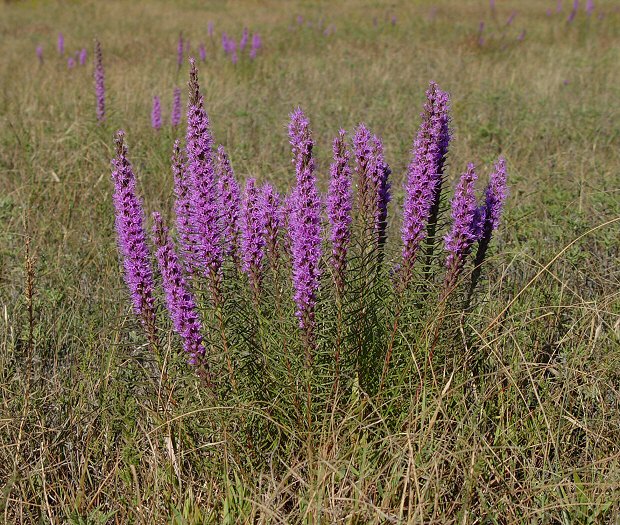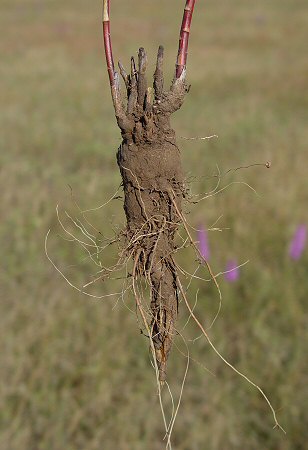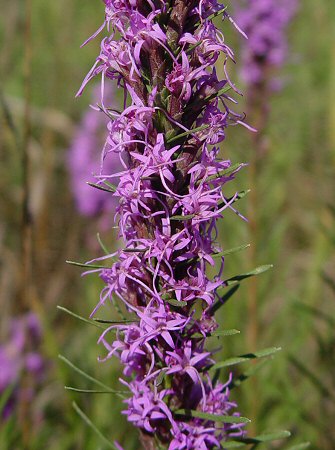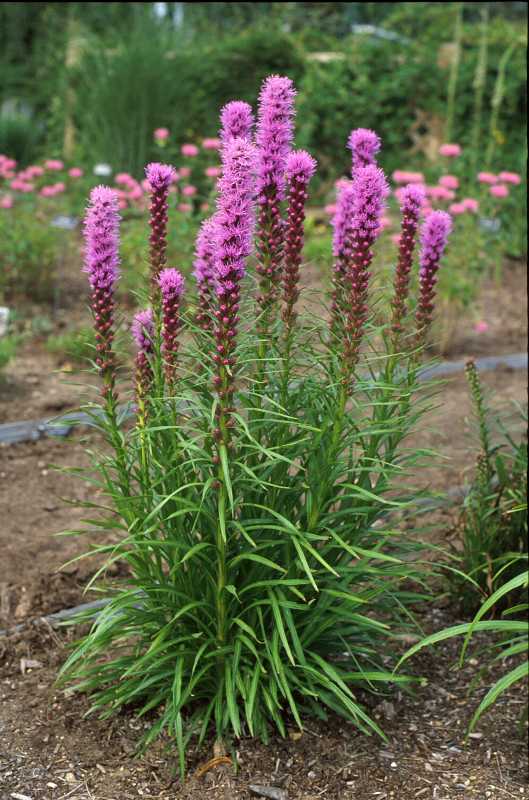
Liatris punctata, Dotted Blazing Star, photo by Missouri Plants.
If you study ethnobotany one thing you will learn is that natives often used several species in a genus without making any distinction between them. This was quite true of several “ground cherries” found in Florida. They used them interchangeably. This may also be true with some Liatris of which there are 43 species, all native to North America.
Liatris’ purple spike of flowers doesn’t suggest any edibility. Indeed, until a few years ago I knew it as sporadic wildflower that would lie dormant for perhaps a century before blooming (after being coaxed out of slumber by a forest fire. ) But a few Liatris, perhaps more, put on an edible tuber. Just make sure you are not cooking up a rare one for dinner.

Liatris punctata root, photo by Missouri Plants
Charles M. Allen in his book “Edible Plants of the Gulf South” makes no distinction between the 43 species of Liatris. He says the root is edible. Couplan in his “Encyclopedia of Edible Plants of North America” is more specific. He writes L. punctata have edible “corms.” Couplan adds that L. scariosa, L. spictata, and L. squarrosa were used as a diuretic and that L. ohlingera is endangered. Moerman in “Native American Food Plants” says the roots of L. punctata and L. punctata var. punctata were baked and eaten by various tribes. There is little doubt the L. punctata was eaten. But there are also suggestions L. spicata — found locally — was eaten as well. Complicating this is the fact L. punctata (the Dotted Blazing Star) is rare in someplaces and prolific in others. Know what kind of area you are in.

Liatris punctata flower spike, photo by Missouri Plants.
L. punctata is found in 19 states: Arkansas, Colorado, Iowa, Illinois, Kansas, Louisiana, Michigan, Minnesota, Missouri, Montana, North Dakota, Nebraska, New Mexico, Ohio, Oklahoma, South Dakota, Texas, Wisconsin, and Wyoming but endangered in Michigan and Wisconsin. We have at least seven different Liatris species in Florida including L. spicata, or Dense Blazing Star. The others are L. chapmanii, L. elegans, L. gracilis, L. ohlingerae, L. pauciflora, and L. tennuifolia. L. spicata is found east of Mississippi, eastern Canada, and states along the western shore of the Mississippi.

Liatris spicata, the Dense Blazing Star, photo by Missouri Botanical Garden
The carrot-flavored roots have inulin, a polysaccharide also found in Jerusalem artichoke roots. It doesn’t spike blood glucose levels when consumed thus is a starch edible by diabetics. While some stems were used as a famine food other parts of the plant were used medicinally often to treat heart ailments which makes sense as the species contains some coumarin. Plains tribes used the Dotted Blazing Star to make a tea that was used for kidney, bladder, and menstrual problems, water retention, gonorrhea, colic, sore throat and laryngitis. Mashed roots were applied to snake bites. Dry roots were burned like incense to relieve headaches, nosebleeds, and tonsillitis. L. chapmanii and L. gracilis might be active against various human cancers.
Domestic livestock like the Dotted Blazing Star particularly sheep. Rocky Mountain Elk also eat it and White-Tail Deer. A variety of small rodents like it — especially the roots — and it is the only source of food for some butterflies. The species apparently also has toxic pyrrolizidine but in very low levels.
As for the botanical name no one knows for sure why the genus is called Liatris (Lee-AT-tris or lye-AT-tris.) Punctata (punct-TAH-ta) means with dots and spicata (spih-KAY-tah) is flowering with a spike. The genus was created by J.C.D. vom Schreber 1739-1810. He might have used the Gaelic word liatrus, spoon-shaped, as a reference to the sometimes bulbous root.
Green Deane’s Itemized Plant Profile: Liatris
IDENTIFICATION: Liatris punctata: Warm-season perennial, several hairless stems, four to 32 inches high, leaves alternate, numerous, dotted with tiny pits, hairless except of coarse hairs on the edges. Lower leaves usually smaller than those above and soon dropped; flower is a dense spike up to a foot long of pink flowers that turn to dandelion-like pappus. Rhizomatous taproot is short, thick, four to 16 feet deep, with lateral roots at various levels. Roots are grayish-black in cross section. Note the L. spicata has a rounder top than the L. puncatata.
TIME OF YEAR: Anytime however only new root growth is edible.
ENVIRONMENT: Dry, open places, sandy soil
METHOD OF PREPARATION: New portion of roots roasted. (The plant keeps adding to the root.) Sometimes the root was consumed raw.

